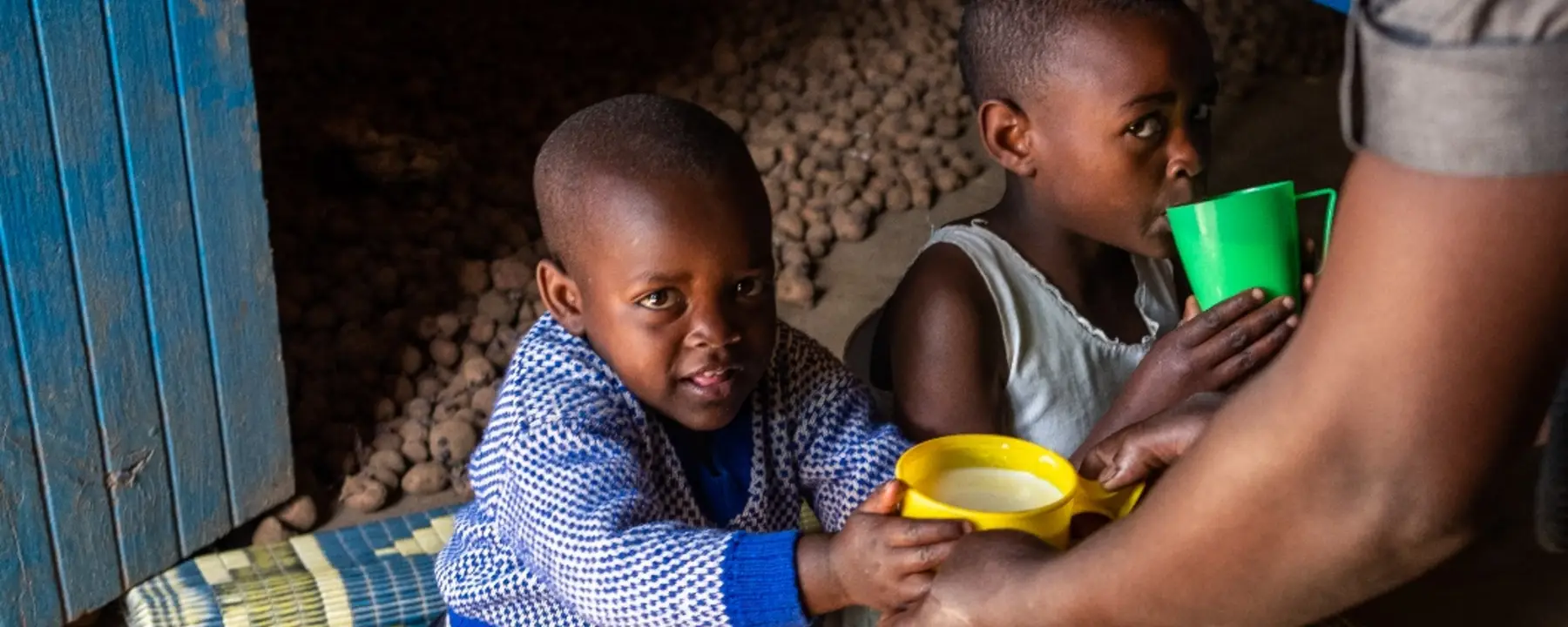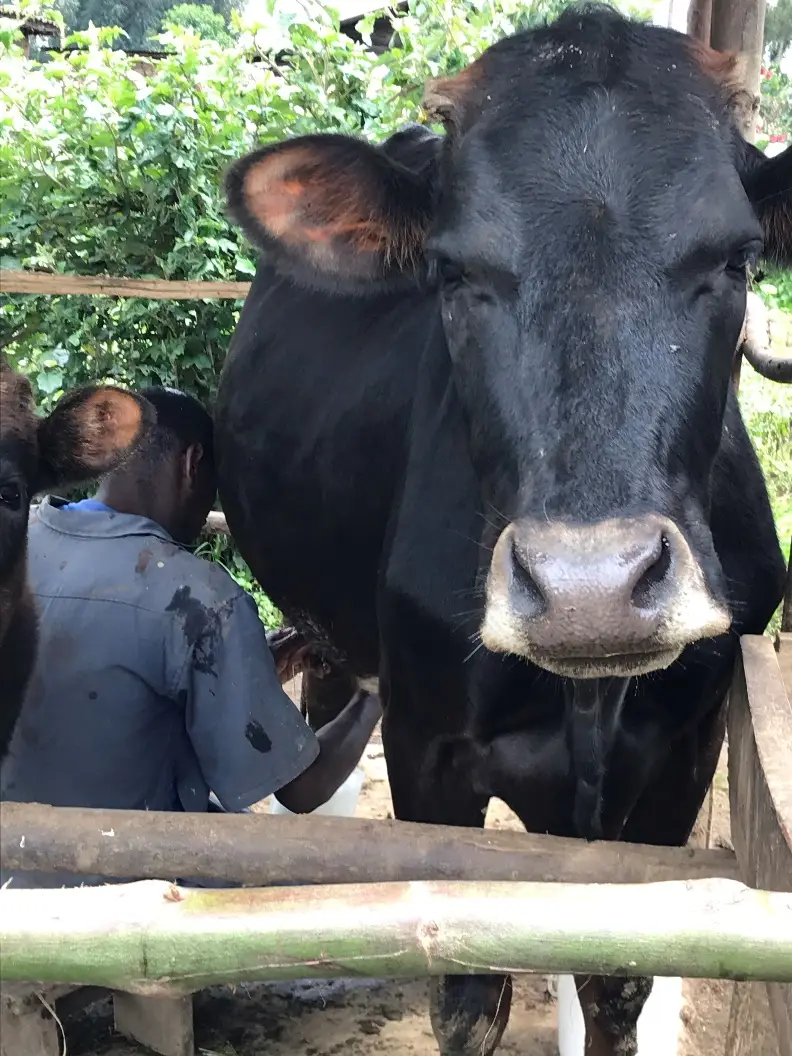Gabura Amata Mubyeyi: Enhancing Child Nutrition in Rwanda with Animal-Source Foods
Children from a nutrition SBC intervention household in Nyabihu district receiving and consuming milk. Photo credit: ILRI Livestock CRP/Jean Bizimana
RTI uses cookies to offer you the best experience online. By clicking “accept” on this website, you opt in and you agree to the use of cookies. If you would like to know more about how RTI uses cookies and how to manage them please view our Privacy Policy here. You can “opt out” or change your mind by visiting: http://optout.aboutads.info/. Click “accept” to agree.

Children from a nutrition SBC intervention household in Nyabihu district receiving and consuming milk. Photo credit: ILRI Livestock CRP/Jean Bizimana
Increase the frequency of milk consumption among young children in households that received a cow through the Girinka program, a national livestock asset transfer program to low-income families in Rwanda.
Develop and test a community-based social and behavior change (SBC) intervention promoting the benefits of consumption of animal-source foods (ASF), including fresh milk, among young children ages 1–3.5 years old.
Our research showed that children in the intervention group were more likely to consume cow’s milk two or more times per week. Mothers and fathers in the intervention group demonstrated increased knowledge and awareness and fathers increased their support for ASF consumption by their children. Community health workers (CHWs), community and environmental health officers (CEHOs), and model fathers (men in the community who previously demonstrated their support for child nutrition), successfully implemented the intervention. SBC messages have been incorporated into national CHW counseling cards, and the intervention is being adapted and scaled up to additional districts.
Animal source foods (ASFs) such as milk, meat, and fish, are important sources of nutrients for children and promote healthy childhood growth. However, these foods are often difficult to access in low- and middle-income countries like Rwanda, where consumption of ASFs among young children is low. In Rwanda, only 27% of children 6–23 months consume milk and 19% consume meat, fish, or poultry. As a result, one-third of Rwandan children under the age of 5 were stunted as of 2020, indicating chronic undernutrition.
Since 2006, the Government of Rwanda has implemented the Girinka “One Cow Per Poor Family” program to provide a female dairy cow to low-income households with the aim of improving household welfare, specifically income, food security, and nutrition. We partnered with the International Livestock Research Institute, Three Stones International, University of Rwanda, and University of Florida to 1) evaluate the effectiveness of this program and 2) determine whether implementing a social and behavior change (SBC) intervention in Girinka households would improve milk consumption among children aged 1–3.5 years.

Girinka cow being milked. Photo credit: ILRI Livestock CRP/Jean Bizimana
We developed the SBC intervention, known as the Gabura Amata Mubyeyi (Parents, Give Milk) program, to provide contextualized health messaging to mothers and fathers through communication materials, household visits, and community activities.
To measure the nutrition impacts of the Girinka program, implement the Gabura Amata Mubyeyi SBC intervention, and assess the intervention’s outcomes, we:
Between February–October 2019, CHWs made 1,451 household visits and carried out 2,379 community activities, with about 3,500 women and 1,300 men participating each month in Ruhango and Nyabihu districts. Between June–October 2021, model fathers conducted 143 community activities, despite a halt of in-person activities in July and August to prevent the spread of Covid-19. Fathers also received key messages by text.
We found that children in households that had received a Girinka cow were taller and heavier for their age than children whose households had not yet received a cow, illustrating the health benefits of owning livestock.
Additionally, our results demonstrated the positive impact of animal-source food SBC messaging on nutrition outcomes in Girinka households. The Gabura Amata Mubyeyi SBC intervention was associated with increased knowledge and awareness of types of ASFs, timing of milk introduction, and food safety among the intervention group. We also found that children in the intervention group consumed milk more frequently following the intervention. A later study found that SBC messages aimed at fathers also improved children’s ASF consumption and increased fathers’ knowledge, awareness, and support for children’s nutrition.
Our studies demonstrated that Rwanda’s longstanding Girinka program contributes to improved childhood nutrition outcomes on its own, but can be enhanced when an SBC intervention is integrated and adapted to the community context. Based on our findings, we developed recommendations that the Government of Rwanda and partners have integrated into national policies. For example, national CHW counseling cards were updated to include the SBC intervention messages around childhood consumption of ASFs and milk.
One of the research partners, Three Stones International, plans to scale this successful SBC intervention to create a more comprehensive and universally applicable SBC strategy for market, development, and government actors across Rwanda who work to increase ASF consumption among vulnerable populations.
Learn more about RTI's global nutrition research
This work was funded in whole or part by the United States Agency for International Development (USAID) Bureau for Resilience, Environment and Food Security under Agreement # AID-OAA-L-15-00003 as part of Feed the Future Innovation Lab for Livestock Systems. Additional funding was received from Bill & Melinda Gates Foundation OPP#060115. Any opinions, findings, conclusions, or recommendations expressed here are those of the authors alone.